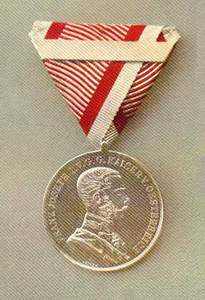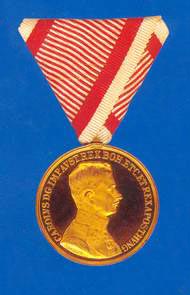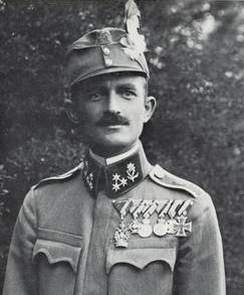The Austrian Golden, Silver and Bronze Bravery Medals 1914-1918
 Kaiser Joseph II first founded a Golden and Silver commemorative medal on the
19th of July 1789 for Non Commissioned Officers and Private Soldiers who had
distinguished themselves before the enemy. Since 1809 this was known as the
Bravery Medal or Tapferkeitsmedaille. On the 19th August 1848 Kaiser Ferdinand
divided the Silver Bravery Medal into two classes - a First and a Second Class.
The 2nd Class Medal being a smaller version with a diameter of 31mm. On the 14th
February 1915 Kaiser Franz Joseph introduced the Bronze Medal which was the same
size as the 2nd Class Silver. Unlike the three senior awards, the Bronze Medal
could be awarded to NCOs and Private Soldiers of allied armies. The Bravery
Medals displayed the reigning Kaiser's head on the obverse. In the case of Franz
Joseph, he was depicted in a Marshals' uniform and the following inscription was
placed around the outer edge of the medal: "FRANZ JOSEPH I. V. G. G. KAISER
V. OESTERREICH" (Franz Joseph I, by the grace of God Emperor of Austria).
The obverse showed six crossed regimental colours surrounded by a laurel wreath
and the motto: "Der Tapferkeit". The diameter of the Gold and large
Silver Medal was 40mm. The ribbon of the Bravery Medal was the same white and
red ribbon as the Military Merit Cross. An Imperial Decree of the 29th November
1915 introduced bars for repeat awards and these took the form of an 8mm wide
smooth rustless iron bar. The recipient of a Bravery Medal was entitled to a
lifelong pension and as ordered by the "Zirkularverordnung" of 18th
September 1914 the sums were as follows with effect from the1st October 1914:
Kaiser Joseph II first founded a Golden and Silver commemorative medal on the
19th of July 1789 for Non Commissioned Officers and Private Soldiers who had
distinguished themselves before the enemy. Since 1809 this was known as the
Bravery Medal or Tapferkeitsmedaille. On the 19th August 1848 Kaiser Ferdinand
divided the Silver Bravery Medal into two classes - a First and a Second Class.
The 2nd Class Medal being a smaller version with a diameter of 31mm. On the 14th
February 1915 Kaiser Franz Joseph introduced the Bronze Medal which was the same
size as the 2nd Class Silver. Unlike the three senior awards, the Bronze Medal
could be awarded to NCOs and Private Soldiers of allied armies. The Bravery
Medals displayed the reigning Kaiser's head on the obverse. In the case of Franz
Joseph, he was depicted in a Marshals' uniform and the following inscription was
placed around the outer edge of the medal: "FRANZ JOSEPH I. V. G. G. KAISER
V. OESTERREICH" (Franz Joseph I, by the grace of God Emperor of Austria).
The obverse showed six crossed regimental colours surrounded by a laurel wreath
and the motto: "Der Tapferkeit". The diameter of the Gold and large
Silver Medal was 40mm. The ribbon of the Bravery Medal was the same white and
red ribbon as the Military Merit Cross. An Imperial Decree of the 29th November
1915 introduced bars for repeat awards and these took the form of an 8mm wide
smooth rustless iron bar. The recipient of a Bravery Medal was entitled to a
lifelong pension and as ordered by the "Zirkularverordnung" of 18th
September 1914 the sums were as follows with effect from the1st October 1914:
| Golden Bravery Medal |
30 Crowns per month |
| Silver Bravery Medal 1st Class |
15 Crowns per month |
| Silver Bravery Medal 2nd Class |
7.50 Crowns per month |
The Bronze Bravery Medal did not attract a pension and repeat
awards did not result in an higher payment for the recipients.
 |
 |
| Golden Bravery Medal bearing the Portrait of
Kaiser Karl |
Hauptmann Johann Charvát. Twice awarded the
Golden Bravery Medal for officers |
With effect from the 4th April 1917 as published in the Normal-Verordnungsblatt
Nr.18 new versions of the Medal were introduced bearing the new Kaiser's
portrait and the inscription: CAROLVS D. G. IMP. AVST. REX BOH. ETC. ET
REX APOST. HVNG." on the obverse. The reverse was altered to bear the Motto
"FORTITVDINI". A further change was the newly introduced eligibility
for Commissioned Officers to be awarded the Golden and Silver Bravery Medals
with effect from the 15th of September 1917 although the Officers' Awards did
not attract the monthly pension. The Officers' version was distinguished by the
addition to the triangular ribbon of a gold or silver "K". Although
the awards to NCOs and Men were delegated to Army Commanders in the field those
of the Golden and Silver Medals for Officers remained an Imperial prerogative.
The Most decorated Non Commissioned officer of the
Austro-Hungarian Army was Feldpilot Offiziersstellvertreter Julius Arigi
(1895-1981). He was awarded the Golden Bravery Medal four times, the Silver 1st
Class four times and both the Silver 2nd Class and the Bronze twice each.
Kaiserschützen-Hauptmann Johann Charvát (1888-1934) was the only commissioned
Officer to be awarded the Golden Bravery Medal twice. The only person to win
both the NCOs and Soldiers' and the Officers' Golden Bravery Medal was Karl
Ritter von Eiss. He won his NCOs and Solders, variant as a Kadett in May 1915
and the Officers' version as an Oberleutnant in der Reserve in the Autumn of
1918.
Back to Orders and Decorations

 Kaiser Joseph II first founded a Golden and Silver commemorative medal on the
19th of July 1789 for Non Commissioned Officers and Private Soldiers who had
distinguished themselves before the enemy. Since 1809 this was known as the
Bravery Medal or Tapferkeitsmedaille. On the 19th August 1848 Kaiser Ferdinand
divided the Silver Bravery Medal into two classes - a First and a Second Class.
The 2nd Class Medal being a smaller version with a diameter of 31mm. On the 14th
February 1915 Kaiser Franz Joseph introduced the Bronze Medal which was the same
size as the 2nd Class Silver. Unlike the three senior awards, the Bronze Medal
could be awarded to NCOs and Private Soldiers of allied armies. The Bravery
Medals displayed the reigning Kaiser's head on the obverse. In the case of Franz
Joseph, he was depicted in a Marshals' uniform and the following inscription was
placed around the outer edge of the medal: "FRANZ JOSEPH I. V. G. G. KAISER
V. OESTERREICH" (Franz Joseph I, by the grace of God Emperor of Austria).
The obverse showed six crossed regimental colours surrounded by a laurel wreath
and the motto: "Der Tapferkeit". The diameter of the Gold and large
Silver Medal was 40mm. The ribbon of the Bravery Medal was the same white and
red ribbon as the Military Merit Cross. An Imperial Decree of the 29th November
1915 introduced bars for repeat awards and these took the form of an 8mm wide
smooth rustless iron bar. The recipient of a Bravery Medal was entitled to a
lifelong pension and as ordered by the "Zirkularverordnung" of 18th
September 1914 the sums were as follows with effect from the1st October 1914:
Kaiser Joseph II first founded a Golden and Silver commemorative medal on the
19th of July 1789 for Non Commissioned Officers and Private Soldiers who had
distinguished themselves before the enemy. Since 1809 this was known as the
Bravery Medal or Tapferkeitsmedaille. On the 19th August 1848 Kaiser Ferdinand
divided the Silver Bravery Medal into two classes - a First and a Second Class.
The 2nd Class Medal being a smaller version with a diameter of 31mm. On the 14th
February 1915 Kaiser Franz Joseph introduced the Bronze Medal which was the same
size as the 2nd Class Silver. Unlike the three senior awards, the Bronze Medal
could be awarded to NCOs and Private Soldiers of allied armies. The Bravery
Medals displayed the reigning Kaiser's head on the obverse. In the case of Franz
Joseph, he was depicted in a Marshals' uniform and the following inscription was
placed around the outer edge of the medal: "FRANZ JOSEPH I. V. G. G. KAISER
V. OESTERREICH" (Franz Joseph I, by the grace of God Emperor of Austria).
The obverse showed six crossed regimental colours surrounded by a laurel wreath
and the motto: "Der Tapferkeit". The diameter of the Gold and large
Silver Medal was 40mm. The ribbon of the Bravery Medal was the same white and
red ribbon as the Military Merit Cross. An Imperial Decree of the 29th November
1915 introduced bars for repeat awards and these took the form of an 8mm wide
smooth rustless iron bar. The recipient of a Bravery Medal was entitled to a
lifelong pension and as ordered by the "Zirkularverordnung" of 18th
September 1914 the sums were as follows with effect from the1st October 1914:
